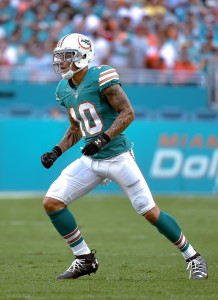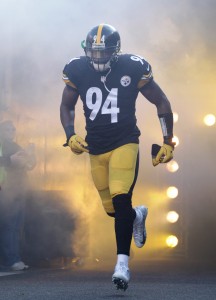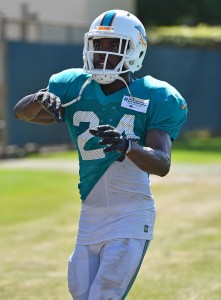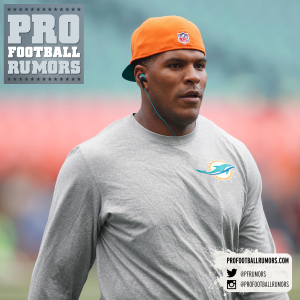The Dolphins were 1-4 last October 9 and looked poised to miss the playoffs for the eighth consecutive season in what would have been a disappointing first go-round for new head coach Adam Gase. Miami rebounded, however, reeling off six straight victories, winning nine of its final 11 games, and finishing with a 10-6 record and a Wild Card berth. Starting quarterback Ryan Tannehill missed the Dolphins’ final three regular season games and their postseason contest with a knee injury, a precursor to another health issue that would cause Miami to re-calibrate in the first week of August 2017.
Notable signings:
- Kenny Stills, WR: Four years, $32MM. $16.95MM guaranteed.
- Andre Branch, DE: Three years, $24MM. $16.8MM guaranteed.
- Lawrence Timmons, DE: Two years, $12MM. $11MM guaranteed.
- Jay Cutler, QB: One year, $10MM. $5MM guaranteed. $3MM available via incentives.
- Nate Allen, S: One year, $3.4MM. Fully guaranteed.
- Jermon Bushrod, G: One year, $3MM. $2.25MM guaranteed.
- Ted Larsen, OL: Three years, $5.65MM. $1.75MM guaranteed.
- Anthony Fasano, TE: One year, $2.75MM. $1.25MM guaranteed.
- Rey Maualuga, LB: One year, minimum salary benefit. $80K guaranteed.
- Alterraun Verner, CB: One year, minimum salary benefit. $80K guaranteed.
- John Denney, LS: One year, minimum salary benefit. $40K guaranteed.
- Damien Williams, RB: One year, $1.797MM. Signed original round RFA tender.
- T.J. McDonald, S: One year, $1.344MM.
- David Fales, QB: One year, $690K.
If you took a long weekend near the beginning of August, you may have missed the entire Jay Cutler-to-Miami saga — it happened that quickly. On August 3, Ryan Tannehill, who had missed the end of the 2016 campaign with an ACL/MCL sprain, went down during Dolphins practice, leading the club’s decision-makers to “fear the worst” in regards to their starting quarterback’s health. Just four days later, Cutler was back in the NFL, having un-retired and left his gig as a FOX analyst in order to sign a one-year deal with Miami.
Cutler, of course, was completely ineffective a year ago, posting one of the worst seasons of his career. But just one year prior, working under then Bears offensive coordinator Adam Gase, Cutler produced an excellent campaign that included the best quarterback rating and second-best completion percentage of his NFL tenure. In fact, Cutler’s 2015 numbers were remarkably similar to those of Tannehill in 2016. The following table contrasts Cutler and Tannehill’s statistics under Gase in 2015 and 2016, respectively, and the figures are indexed (courtesy of Pro Football Reference), meaning 100 is league average and a higher number is better:
Tannehill was a bit better in 2016 than Cutler was in 2015, but if Cutler can come close to matching Tannehill’s performance from last season, and keep Miami in the top half of the offensive DVOA rankings, the Dolphins would likely be content. If Cutler does reach that level, Miami would be facing several questions next offseason, especially if they have interest in retaining Cutler beyond 2016. The Dolphins, for what’s it worth, can release Tannehill next offseason in a move that would save $15.2MM against the cap (and incur only $4.6MM in dead money). Whether that’s a viable scenario depends entirely on Cutler’s showing, and whether Tannehill can pass a physical next spring.
Cutler will be throwing the ball to an impressive group of wide receivers that includes Jarvis Landry, DeVante Parker, and Kenny Stills, the latter of whom re-signed with the Dolphins on a four-year pact. Stills, 25, posted a career-high nine touchdowns last season, and eight of those scores came on receptions of 20+ yards, tying him with Antonio Brown for the most deep scores among pass-catchers. Although pre-free agency rumors indicated Stills could garner upwards of $12MM annually on the open market, Miami inked Stills for only $8MM per season, an annual salary that ranks just 21st among wideouts.
In order for Stills to get deep, the Dolphins’ offensive line will need to hold up better than it did last season, when the unit ranked 21st in adjusted sack rate. Miami believed it could rectify its guard situation on the cheap, and the club didn’t spent much money to upgrade its interior. Jermon Bushrod is back at right guard after finishing 26th in snaps per blown block a year ago, per the 2017 Football Outsiders Almanac, while free agent addition Ted Larsen won’t contribute in 2016 after tearing his biceps, meaning the inexperienced Jesse Davis is now projected to start at left guard. Tight end Anthony Fasano, now in his second stint in South Beach, should be able to help on the edge, as he graded as the league’s No. 1 blocking tight end in 2016, according to Pro Football Focus.
On the defensive side of the ball, the Dolphins made a number of curious signings, and that list starts with defensive end Andre Branch. Let’s go back to 2016, when Miami originally signed Branch: he was coming off a season with the Jaguars in which he saw 597 defensive snaps and managed four sacks and 18 hurries. The Dolphins inked Branch to a one-year pact worth only $3MM. In his first season with Miami, Branch improved to 5.5 sacks and 20 hurries, but had to play nearly 200 more snaps to get there. Keeping in mind that he’s now one year older, does the Dolphins’ evaluation of Branch as a $8MM per year player make any sense? Just 12 months after finding a value on the free agent scrap heap, Miami over corrected and made Branch a top-20 edge rusher in terms of annual salary.
Football operations chief Mike Tannenbaum and general manager Chris Grier‘s indefensible decisions continued at the second level, as the signing of former Steelers linebacker Lawrence Timmons was a clear overpay. The 31-year-old Timmons wasn’t linked to any other clubs besides the Dolphins in free agency, so it’s possible Miami was negotiating against itself as it agreed to a two-year deal that includes $11MM guaranteed. Timmons can’t cover anymore, and while some of his pass defense struggles may have been a product of Pittsburgh’s scheme, the Dolphins are going to be disappointed if Timmons is asked to play in nickel packages. Fellow Miami addition Rey Maualuga finished only 11 spots worse than Timmons in PFF’s linebacker rankings, and he signed a minimum salary benefit contract, further exposing the mistake that is Timmons’ deal.
The Dolphins went bargain-hunting in the secondary, signing low-cost free agents such as Nate Allen, T.J. McDonald, and Alterraun Verner. Allen, who served as the Raiders’ third safety last season, figures to start for Miami for the first half of the 2017 campaign as McDonald serves an eight-game suspension. The Dolphins knew McDonald was banned before they signed him, and perhaps saw an opportunity to land a 26-year-old safety with 53 starts under his belt on a cheap deal. Verner, meanwhile, didn’t find a deal until July, but he could play a larger role than expected now that Tony Lippett is lost for the year with a torn Achilles.
Notable losses:
- Isa Abdul-Quddus, S: Released
- Donald Butler, LB
- Jordan Cameron, TE: Retired
- Chimdi Chekwa, CB
- Jelani Jenkins, LB
- Dominique Jones, TE
- Dion Jordan: Waived
- Earl Mitchell, DT: Released
- Spencer Paysinger, LB
- Bacarri Rambo, S
- Dion Sims, TE
- Mario Williams, DE: Released
- T.J. Yates, QB
Despite boasting excellent players like Ndamukong Suh and Cameron Wake, the Dolphins’ defensive line was still a weakness last season, finishing 18th in adjusted line yards and 31st in adjusted sack rate. With an eye towards improving that ranking, Miami began releasing dead weight this spring, cutting ties with Earl Mitchell, Mario Williams, and Dion Jordan. The releases of Williams and Jordan are understandable: Williams was overpaid during his one season with the Dolphins and didn’t offer much at defensive end, while Jordan is one of the larger draft busts in recent memory. Letting Mitchell go is a bit more peculiar, however, especially given that Miami is now on the hunt for a defensive tackle that does exactly what Mitchell did — stop the run. Mitchell didn’t offer any pass rush, but the Dolphins have Suh for that, so cutting a serviceable veteran and creating a new area of need wasn’t the wisest route.
Miami didn’t particularly have a decision to make on safety Isa Abdul-Quddus, as the 2016 free agent addition suffered a serious neck injury near the tail end of last season. IAQ, who was excellent in his first season with the Dolphins, is potentially facing the end of his career, as neck issues aren’t to be trifled with — as of March, Miami wasn’t sure whether Abdul-Quddus would be able to resume football activities. Bacarri Rambo, who played roughly 40% of the Dolphins’ snaps while filling in for Reshad Jones, is also gone, meaning Miami will be without the two safeties who saw the most playing time for the club last year.
On offense, the Dolphins witnessed the loss of two tight ends, Dion Sims and Jordan Cameron. Sims landed one of the more surprising contracts of the free agent period, as he inked a three-year, $18MM pact with the Bears that contains $6MM in guarantees. Sims, 26, has never topped 30 receptions or 300 yards receiving during his four-year career, but the Dolphins reportedly wanted to retain him ever after acquiring Julius Thomas from the Jaguars. Cameron, meanwhile, announced his retirement after suffering four concussions in four seasons. He managed only three appearances and eight receptions in 2016.
Trades:
- Acquired a 2018 seventh-round pick from the Jaguars in exchange for T Branden Albert (pick returned to Jacksonville due to Albert’s retirement).
- Acquired TE Julius Thomas from the Jaguars in exchange for a 2017 seventh-round pick (No. 240).
- Acquired DE William Hayes and a 2017 seventh-round pick (No. 223) from the Rams in exchange for a 2017 sixth-round pick (No. 206).
- Acquired a 2017 fifth-round pick (No. 164; OL Isaac Asiata) and a 2017 sixth-round pick (No. 194; DT Vincent Taylor) from the Eagles in exchange for a 2017 fifth-round pick (No. 166; WR Shelton Gibson) and a 2017 fifth-round pick (No. 184; S Nathan Gerry).
- Acquired a 2017 seventh-round pick (No. 237; WR Isaiah Ford) and a 2018 seventh-round pick from the Buccaneers in exchange for a 2017 seventh-round pick (No. 223; DT Steve Tu’ikolovatu).
Jay Cutler isn’t the only player with a history of success under Adam Gase whom the Dolphins acquired this offseason. Tight end Julius Thomas is heading to Miami, as well, after the Dolphins agreed to send a late-round selection to Jacksonville (some initial reports indicated Thomas would be swapped for tackle Branden Albert, but the Dolphins and Jaguars ended up making separate deals involving those players).
Thomas, 29, hasn’t done anything to live up to the five-year, $46MM contract he signed with Jacksonville prior to the 2015 campaign, as he averaged only 38 receptions and 268 yards through two years with the Jags. He posted superb numbers with Gase in Denver, however, including back-to-back seasons with 12 touchdown receptions. Those high-scoring years came in a Peyton Manning-led offense, but there’s some hope that Thomas can come closer to his Denver level of production than his Jacksonville statistics. Manning, for what’s worth, had a hand Miami’s acquisition of Thomas, as he spoke with Dolphins offensive coordinator Clyde Christensen before the Fins made the move.
While Thomas was Miami’s most notable trade addition, the club also acquired William Hayes at essentially no cost, moving down only 17 spots in the draft in order to bring in the veteran defensive end. That the Dolphins were able to pick up Hayes for such a small price is still rather astonishing, as the 32-year-old is a more-than-viable rotational lineman after grading as the NFL’s No. 17 edge defender on 514 snaps last season, per PFF. Since 2012, Hayes has managed at least 24 quarterback pressures in every season, and has missed only four total games during that span.
Draft picks:
- 1-22: Charles Harris, DE (Missouri)
- 2-54: Raekwon McMillan, LB (Ohio State)
- 3-97: Cordrea Tankersley, CB (Clemson)
- 5-164: Isaac Asiata, OL (Utah)
- 5-178: Davon Godchaux, DT (LSU)
- 6-194: Vincent Taylor, DT (Oklahoma State)
- 7-237: Isaiah Ford, WR (Virginia Tech)
Defensive end was considered a priority for the Dolphins as far back as February, so it wasn’t stunning when the club selected Missouri edge rusher Charles Harris with the 22nd overall pick. Harris — who “explodes out of his stance,” per Lance Zierlein of NFL.com — managed nine sacks a season ago, and also posted a sack, hit, or hurry once every six pass-rushing attempts in 2016, per PFF. The only problem? There’s no place for Harris to play at the moment after the Dolphins extended Cameron Wake, re-signed Andre Branch, and acquired William Hayes. Harris will see rotational work, to be sure, but he won’t be a Day 1 starter in South Beach.
The same isn’t true for fifth-round pick Davon Godchaux, though, as the LSU product is expected to work as a starter at defensive tackle. It’s a surprising turnaround for Godchaux, as the Dolphins didn’t believe he nor fellow rookie Vincent Taylor were capable of serving even as rotation players as recently as late June. Although he’s a bit slow off the snap, Godchaux has the strength necessary to play against the run game, according to Matt Miller of Bleacher Report, who compared Godchaux to pro defenders Glenn Dorsey and Ego Ferguson.
The rest of Miami’s rookie class probably won’t see all that much action during the upcoming season. Raekwon McMillan had been poised to serve as a starting linebacker for the Dolphins, but he’s lost for the season after suffering a torn ACL. Cornerback Cordrea Tankersley has been called “stiff” by some in the Miami organization, and he’s not expected to play a large role even following the season-ending injury to fellow defensive back Tony Lippett. Similarly, Ted Larsen‘s torn biceps won’t affect the status of first-year guard Isaac Asiata, who is still working with Miami’s second team.
Extensions and restructures:
- Reshad Jones, S: Extended through 2021. Four years, $48MM. $19.885MM guaranteed.
- Kiko Alonso, LB: Extended through 2020. Four years, $28.91MM. $16MM guaranteed.
- Cameron Wake, DE: Extended through 2018. One year, $9.125MM. $7.875MM guaranteed.
- William Hayes, DE: Reworked contract. Deleted 2018 season in exchange for reducing 2017 base salary from $3.5MM to $2.7MM. $2MM signing bonus. $50K workout bonus.
- Koa Misi, LB: Accepted pay cut. Reduced 2017 base salary from $4.175MM to $1.125MM. $1.15MM guaranteed.
While we’ve already discussed the Dolphins’ strange decisions in free agency (Andre Branch, Lawrence Timmons), the club also made some bizarre calls with regards to extensions. Reshad Jones is Exhibit A: while he’s been one of the league’s best (and most underrated) safeties in recent seasons, Jones is now nearing age-30 and coming off a campaign in which he missed 10 games with a torn rotator cuff. Faced with that information, most teams likely would have let Jones play out the final year of his contract in 2017 before looking into an extension. Miami, on the other hand, made Jones the NFL’s third-highest-paid safety on an annual basis and handed him nearly $20MM in full guarantees on a deal that Jason Fitzgerald of Over the Cap calls one of the worst in the AFC East.
Linebacker Kiko Alonso‘s extension was another strange ordeal, especially given that he was a restricted free agent this spring. Miami’s first mistake was tendering Alonso at the first-round level at a cost of nearly $4MM — the second-round tender would have been more than sufficient, as no opposing club was going to cough up a Day 2 selection for the right to sign Alonso. The Dolphins then compounded that error, extending Alonso on a four-year deal that — given Miami’s team control over Alonso in 2017 — essentially valued the former Oregon Duck as an $8.3MM player, right around the range of a Dont’a Hightower. Alonso was serviceable during his first year with the Dolphins, but his lack of availability is concerning, as he played only 472 snaps from 2014-15.
Other:
- Promoted Matt Burke to defensive coordinator to replace Vance Joseph.
- Exercised 2018 fifth-year option for T Ja’Wuan James ($9.341MM).
- Placed QB Ryan Tannehill on injured reserve (torn ACL).
- Placed OL Ted Larsen on injured reserve (torn biceps).
- Placed LB Koa Misi on injured reserve (neck).
- Learned CB Tony Lippett would miss the 2017 season (torn Achilles).
- Learned LB Raekwon McMillan would miss the 2017 season (torn ACL).
- Learned before signing T.J. McDonald he would be suspended eight games (substance abuse).
- Signed 14 undrafted rookie free agents.
Top 10 cap charges for 2017:
- Ryan Tannehill, QB: $20,300,000
- Ndamukong Suh, DT: $19,100,000
- Jay Cutler, QB: $10,000,000
- Mike Pouncey, C: $8,975,000
- Byron Maxwell, CB: $8,500,000
- Cameron Wake, DE: $7,500,000
- Julius Thomas, TE: $5,600,000
- Andre Branch, DE: $5,000,000
- William Hayes, DE: $4,750,000
- Lawrence Timmons, LB: $3,775,000
No one expected Jay Cutler to be leading the Dolphins in 2017, but if he, running back Jay Ajayi, and a cavalcade of offensive weapons can keep Miami on schedule, the club could be in contention for another Wild Card berth (an AFC East crown looks completely untenable due to the presence of the Patriots). It’s Miami’s defense that may prove critical next season, as the unit and new coordinator Matt Burke needs to improve on its No. 19 DVOA ranking in order for the Dolphins to take a leap. If it does, the playoffs aren’t a unreasonable goal in South Beach.
Information from Over the Cap and Roster Resource was used in the creation of this post. Photos courtesy of USA Today Sports Images.

